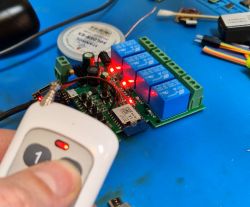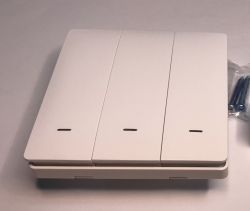FAQ
TL;DR: Six 10 W lamps total ~60 W, "20× less than the strength of the switch"; so "connect directly" when within rating. [Elektroda, starob, post #19448759]
Why it matters: This helps ABAX2/ASW‑210 users light multi‑lamp alleys safely without overspending on unnecessary LED power supplies.
Quick Facts
- ASW‑210 relay rating: AC1 category 1250 VA (resistive reference point). [Elektroda, starob, post #19448198]
- Example load: six × 10 W ≈ 60 W; judged 20× below switch strength, so acceptable. [Elektroda, starob, post #19448759]
- Manual guidance in thread: one LED power supply per relay output. [Elektroda, chudy_b, post #19447885]
- Workaround suggested: drive an external relay with a 230 V coil from ASW‑210. [Elektroda, kood, post #19447906]
- Budget note: one vs six drivers was reported as ~£1,000 difference. [Elektroda, chudy_b, post #19447885]
Can one ASW‑210 control six LED lamps on a single daisy‑chain?
Yes, when the total load is small relative to the AC1 rating. Six 10 W lamps are about 60 W. That was called “20× less than the strength of the switch,” with the guidance to connect directly. Keep wiring tidy and respect protective devices. [Elektroda, starob, post #19448759]
Why does the manual say “one LED power supply per relay”?
LED drivers can be capacitive or inductive. Their inrush or back‑EMF stresses small relay contacts. The limit protects the module’s contacts from premature wear. Offloading the switching to a proper mains relay avoids that stress on the ASW‑210. [Elektroda, kood, post #19447906]
How do I protect ASW‑210 contacts when switching multiple LED drivers?
Place an external mains relay near the lamps and switch its coil with the ASW‑210. That moves the heavy switching to the external relay’s contacts. As one expert put it, “use a relay with a 230 V coil.” Choose a relay with suitable inrush ratings. [Elektroda, kood, post #19447906]
Is a 230 V relay coil an inductive load, and is that a problem?
Yes, it is inductive, but the current is tiny. “The coil of a 230V relay consumes a few or several mA,” so the ASW‑210 sees a light load. This approach significantly reduces contact stress compared with switching LED drivers directly. [Elektroda, kood, post #19447974]
I have only one 3×2.5 mm² cable lamp‑to‑lamp. How should I wire it?
Mount the ASW‑210 and an external relay in the first lamp’s box. Feed the relay’s switched output down the daisy‑chain to power the remaining lamps. This keeps control local and uses your existing single‑run wiring effectively. [Elektroda, kood, post #19447997]
How‑To: Use one ASW‑210 to switch six garden LED lamps
- Install ASW‑210 and a 230 V coil relay in the first lamp enclosure.
- Wire ASW‑210 output to the relay coil; supply the relay contacts from mains.
- Run the relay’s switched live along the daisy‑chain to all lamps. [Elektroda, kood, post #19447997]
I don’t have a control cable near the panel. Can I still automate it?
Yes. The thread context assumes wireless control, so place ASW‑210 at the first lamp. The module then switches the local relay, and your daisy‑chain feeds all lamps. This avoids running a control cable back to the panel. [Elektroda, chudy_b, post #19447902]
What does the AC1 1250 VA figure really mean for my setup?
AC1 is a resistive‑load reference. LED drivers are not purely resistive. Keep a safety margin when switching drivers directly. If uncertain, drive only a relay coil with ASW‑210 and let the external relay handle the supplies. [Elektroda, kood, post #19447974]
Can I place several LED power supplies in parallel after the ASW‑210?
The discussed manual guidance says one LED power supply per relay. Multiple supplies increase inrush and cumulative stress on contacts. If you must power several, re‑arrange so the ASW‑210 drives an external relay instead. [Elektroda, chudy_b, post #19447885]
Will inrush still hit ASW‑210 contacts if the coil and supplies share one cable?
No. The ASW‑210 only switches the relay coil current, which is a few mA. The LED power‑supply inrush occurs on the external relay’s contacts, not on the ASW‑210. This separation preserves the module’s contacts. [Elektroda, kood, post #19447974]
Can I control the lights from the alarm panel OUT instead?
Yes, if the wiring is nearby. Derive control from an OUT and drive a 12/230 V relay. The relay then switches mains to the lamps or drivers. This is a clean alternative when a panel output is available. [Elektroda, sosarek, post #19447915]
Do I need an RC snubber across the contacts?
Not when ASW‑210 only drives a 230 V relay coil. The coil current is very low, so arcing is minimal. Focus snubbers on contacts switching the LED supplies, if needed, per that relay’s datasheet. [Elektroda, kood, post #19447974]
What failure signs show the contacts are overstressed?
Expect contact heating, pitting, or sticking when switching capacitive or inductive drivers directly. These loads strain small relays. Move the heavy switching to a mains‑rated relay to prevent accelerated wear on the ASW‑210. [Elektroda, kood, post #19447906]
How big is the cost impact of using many separate drivers?
The OP reported nearly £1,000 extra for six drivers versus one. Centralizing control and using an external relay can reduce driver count. That helps meet budget while staying within electrical limits. [Elektroda, chudy_b, post #19447885]






